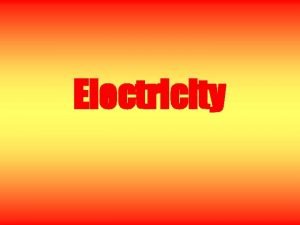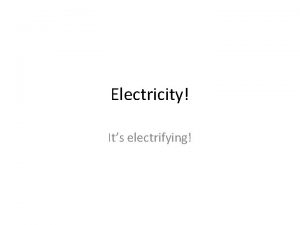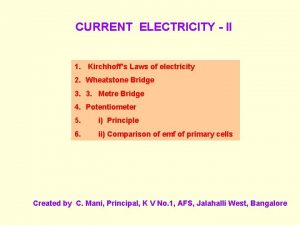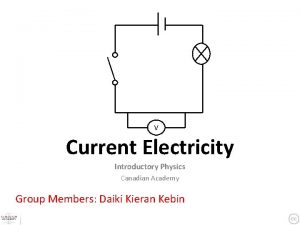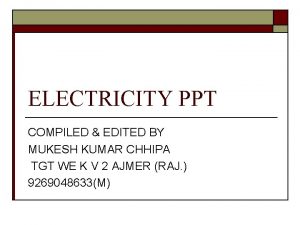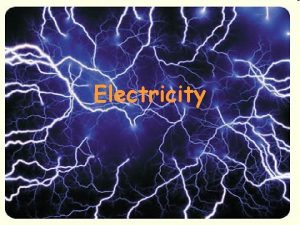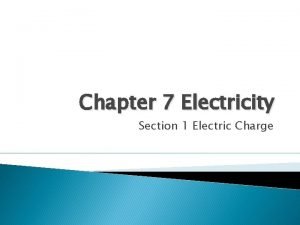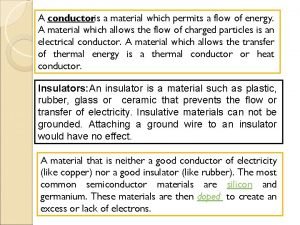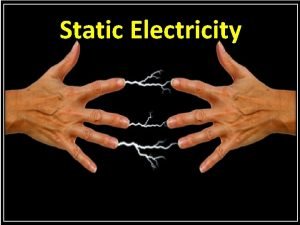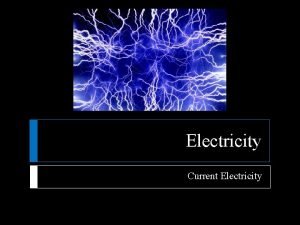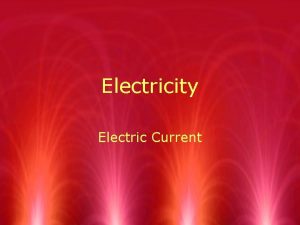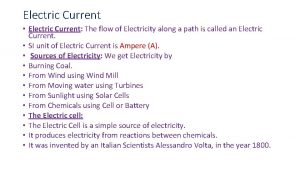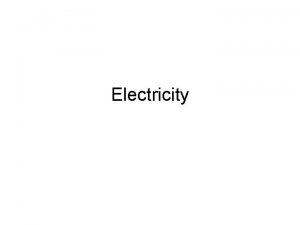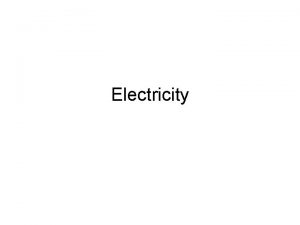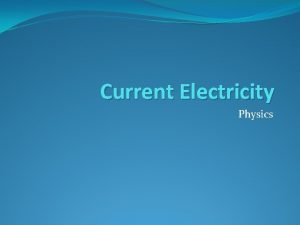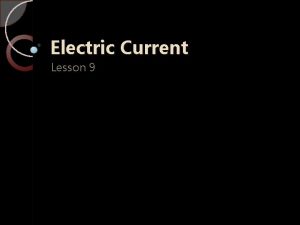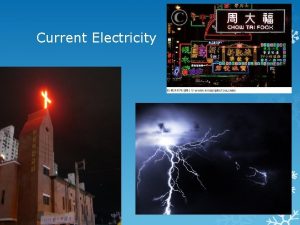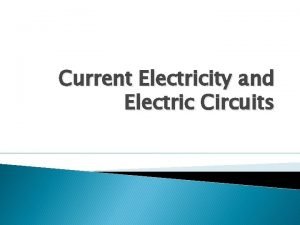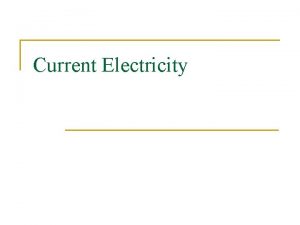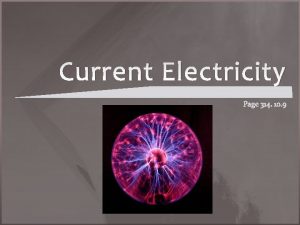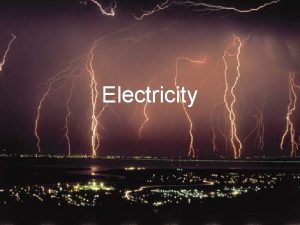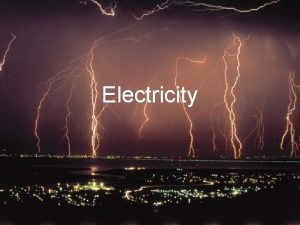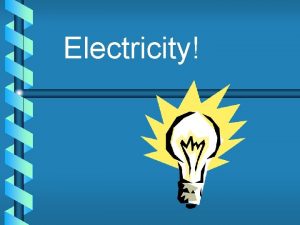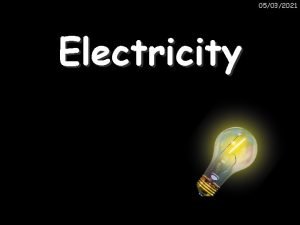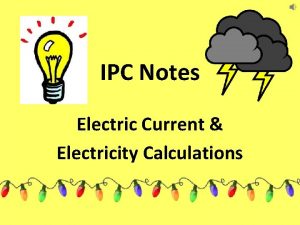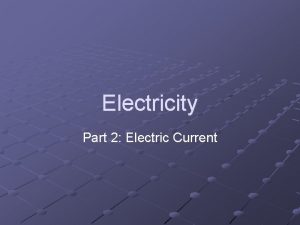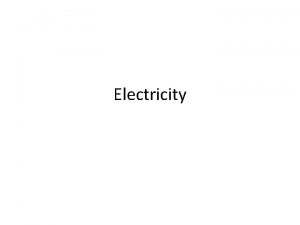Understanding Electricity Electric Current Electric current the flow


























- Slides: 26

Understanding Electricity

Electric Current • Electric current: the flow of electrons through a conductor (like silver, copper, gold, or aluminum) Electrons move in no particular direction, therefore there is no electric current Electrons move in one direction, therefore there is an electric current

Magnets & Electricity • An electric current is produced when a magnet is moved into a coil of wire in a circuit

Magnets & Electricity • http: //www. youtube. com/watch? feature=pl ayer_embedded&v=P 3 k. Jd 3 MDeuk

Open Circuit

Closed Circuit

Voltage • Voltage is the measure of the force that “pushes” electrons through a circuit • Similar to the pressure of water pushing it through pipes

Electric Current • Current is a flow rate of electrons in a circuit and is measured in amperes • 1 ampere (amp) = 6. 24 x 1018 electrons per second • Similar to the flow of water through pipes

Power • Power = energy ÷ time • Ex: – There is more energy in 1 kg of coal than 1 kg of TNT – But, TNT delivers more power because it releases its energy in much less time

Electric Power • Power is the rate that energy is generated or consumed • A watt is 1 Joule per second – Ex: lifting a small apple 1 meter in 1 second • 1 watt is equal to the rate of current flow when 1 volt moves 1 amp through a circuit

Putting It All Together • Watts = Volts x Amps • Ex: Calculate the wattage of a set of speakers with 120 V and 2. 5 amps. • W = 120 V x 2. 5 A = 300 W • Ex: Calculate the amps if the voltage is 120 and the appliance is rated at 650 W. • A = 650 W ÷ 120 V = 5. 4 amps

Scale of Electricity • Kilowatt = 1, 000 watts – Enough to power an average American home at any one time • Megawatt = 1 million watts – Enough to light a stadium at night • Gigawatt = 1 billion watts – Enough to power a major city

Power Plants • Limerick’s two reactors produce 2, 345 megawatts of electricity in total • Enough energy to power more than 2 million average American homes

Electrical Consumption • Power is the rate that energy is generated or consumed, not the amount of energy • The rate of energy that a light bulb uses at any moment would be measured in watts • The amount of energy a light bulb uses over an entire day would be measured in watt-hours (Wh)

Electrical Consumption • Electricity is typically sold by the kilowatt hour (k. Wh) • 1 k. Wh = 1, 000 W of power used for 1 hour • 1 MWh = 1, 000 W of power used for 1 hour

Relationship Between Energy & Power • Energy = power x time • k. Wh = k. W x h • k. Wh = energy • k. W = power • h = time

Relationship Between Energy & Power • A 10 k. W wind turbine can generate 10 k. W of power under optimal conditions • It would be foolish to ask, “How long does it take to generate 10 k. W? ” – It’s similar to asking, “How long does it take to travel 10 miles per hour? ” – 10 k. W is the rate that it can generate energy, not the amount of energy it can generate in a period of time

Relationship Between Energy & Power • Energy is like distance – it’s an amount • Power is like speed – it’s a rate

Typical Wattages of Various Appliances • • • • Clock radio = 10 W Clothes washer = 350– 500 W Clothes dryer = 1800– 5000 W Dishwasher = 1200– 2400 W Hair dryer = 1200– 1875 W Clothes iron = 1000– 1800 W Microwave = 750– 1100 W Refrigerator = 725 W Toaster = 800– 1400 W DVD = 20– 25 W Vacuum cleaner = 1000– 1440 W Water heater = 4500– 5500 W Laptop = 50 W

Electricity Bill


Energy Calculation Problems 1. How much energy (in Joules) does a 75 Watt light bulb use when it is turned on for 25 minutes? 75 W × (1 J/s / 1 W) × (60 sec/1 min) × (25 min) = 112, 500 J

Energy Calculation Problems 2. A 100 Watt light bulb is 20% efficient. a) How many Joules does it use in 12 hours of operation? 100 W × (1 J/s / 1 W) × (60 sec/1 min) × (60 min/ 1 hr) × 12 hr = 4, 320, 000 J

Energy Calculation Problems b) How much energy (in Joules) does the bulb convert to light during 12 hours? 4, 320, 000 J × 0. 2 = 864, 000 J light

Energy Calculation Problems c) How many k. Wh does it use in 12 hours of operation? 100 W × (1 k. W/1, 000 W) × 12 hr = 1. 2 k. Wh

Energy Calculation Problems 3. An electric clothes dryer has a power rating of 4000 W. Assume a family does 5 loads of laundry each week for 4 weeks. Each dryer load takes 1 hour to complete. a) Find the energy used in Joules and k. Wh. 4000 W × (1 J/s / 1 W) × (3600 s/hr) × (1 hr/load) × (5 loads/week) × (4 weeks) = 288, 000 J 288, 000 W× (1 Wh/3, 600 s) = 80, 000 Wh = 80 k. Wh
 Static electricity and current electricity
Static electricity and current electricity Current electricity
Current electricity Magnetism vocabulary
Magnetism vocabulary Kinds of electricity
Kinds of electricity Difference between static and current electricity
Difference between static and current electricity Current electricity def
Current electricity def Bill nye electricity
Bill nye electricity Current electricity
Current electricity What is current electricity in physics
What is current electricity in physics Current electricity ppt
Current electricity ppt Series and parallel circuits similarities
Series and parallel circuits similarities Chapter 6 electricity section 1 electric charge answers
Chapter 6 electricity section 1 electric charge answers Electricity section 1 electric charge
Electricity section 1 electric charge Electricity section 1 electric charge
Electricity section 1 electric charge The material that permits the flow of electricity
The material that permits the flow of electricity Nature flow of electricity
Nature flow of electricity What slows down the flow of electricity in a circuit
What slows down the flow of electricity in a circuit What is static electricity
What is static electricity Understanding signal flow
Understanding signal flow A balanced delta connected load having an impedance 20-j15
A balanced delta connected load having an impedance 20-j15 Power formula three phase
Power formula three phase Drift current and diffusion current
Drift current and diffusion current Ac systems lesson 4
Ac systems lesson 4 Drift current
Drift current Ceramic composition resistors
Ceramic composition resistors At cutoff the jfet channel is
At cutoff the jfet channel is In a y-connected source feeding a ∆-connected load,
In a y-connected source feeding a ∆-connected load,



